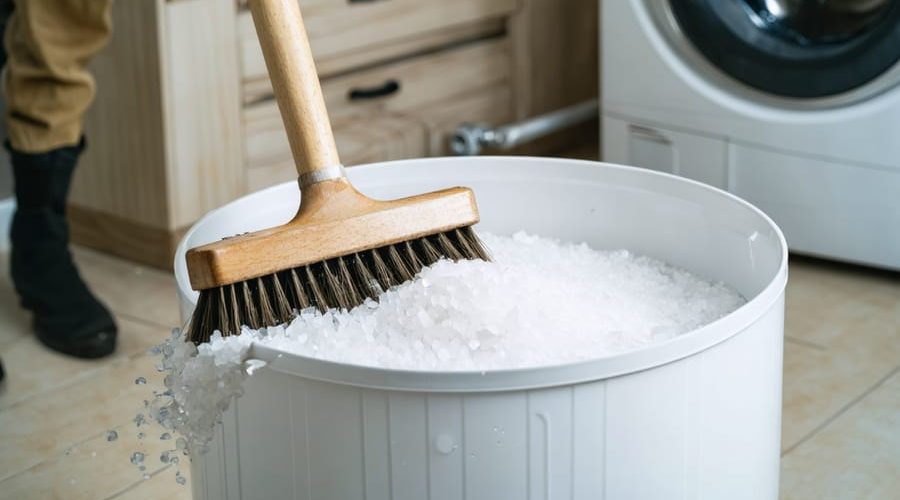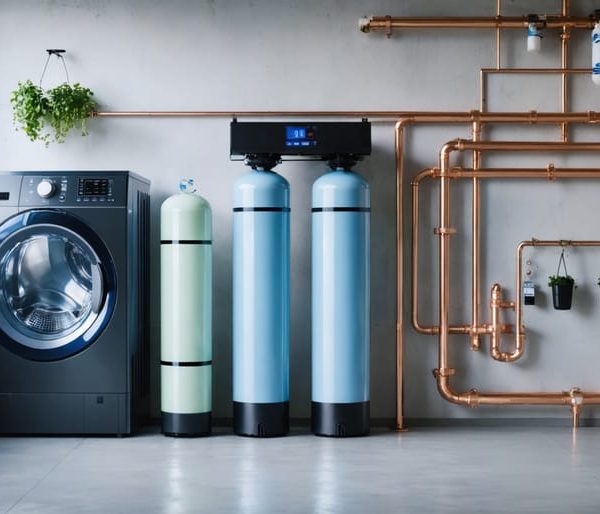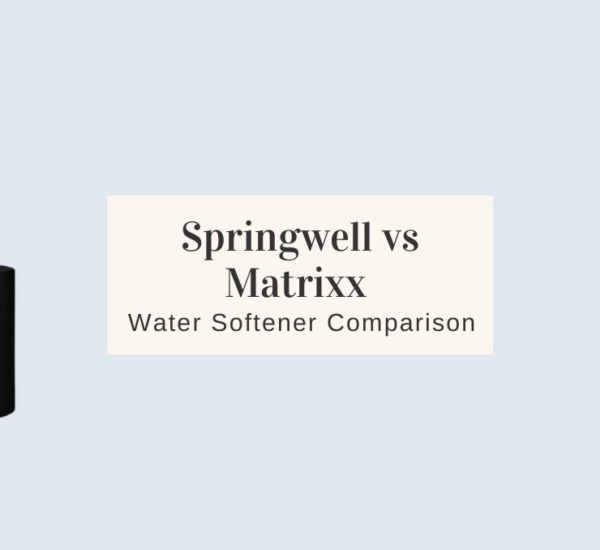Check your water softener brine tank immediately if you notice a solid mass of undissolved salt, commonly called a “salt bridge” or “salt mushing.” This frustrating problem prevents your system from regenerating properly, leaving you with hard water throughout your home. Break up any hardened salt crust by gently pressing down with a broom handle—if it collapses into the water below, you’ve found your culprit.
The root cause typically involves humidity, poor-quality salt, or overfilling your tank. High moisture levels cause salt pellets to bind together before they can dissolve into brine. Low-quality salt containing excessive impurities creates a sludge at the tank bottom that blocks water circulation. When you add too much salt at once, the weight compresses lower layers into an impenetrable mass that water cannot penetrate.
Prevention starts with choosing the right salt type and maintaining proper tank levels. Keep your brine tank only half to two-thirds full, and check it monthly for bridging or mushing. Select high-purity salt pellets specifically designed for water softeners, as these dissolve more consistently than rock salt or cheap alternatives. Understanding these simple maintenance steps protects your investment while ensuring your household continues enjoying the benefits of softened water without interruption.
Understanding How Water Softener Salt Should Dissolve
Understanding how your water softener salt should dissolve is essential for maintaining an efficient system and ensuring your home enjoys consistently soft water. When everything works properly, the salt pellets or crystals in your brine tank gradually dissolve into water, creating a concentrated saltwater solution called brine. This brine is what recharges the resin beads in your softener during regeneration cycles—the process that removes hard minerals like calcium and magnesium from your water supply.
In a healthy system, you’ll notice the water level in your brine tank sitting a few inches below the salt level. The salt above the waterline should appear dry and granular, while below the surface, salt steadily dissolves without clumping together. As your softener runs through regeneration cycles, typically every few days depending on water usage, the salt level gradually decreases in an even, predictable pattern.
Problematic buildup looks quite different. You might spot a thick, crusty bridge of salt suspended above the water, or notice mushy, compacted salt at the bottom of the tank—a condition called “salt mush.” These formations prevent proper brine creation because undissolved salt can’t do its job. Think of it like trying to make saltwater for cooking: if your salt stays clumped at the bottom of the pot instead of mixing in, you won’t get the concentration you need.
When salt doesn’t dissolve correctly, your regeneration cycles become ineffective. The resin beads can’t recharge properly, meaning hard water starts slipping through your system untreated. You’ll notice the telltale signs—spotty dishes, soap that doesn’t lather well, and that familiar mineral buildup returning to your fixtures. Addressing dissolution issues quickly protects both your water quality and your softener’s longevity.
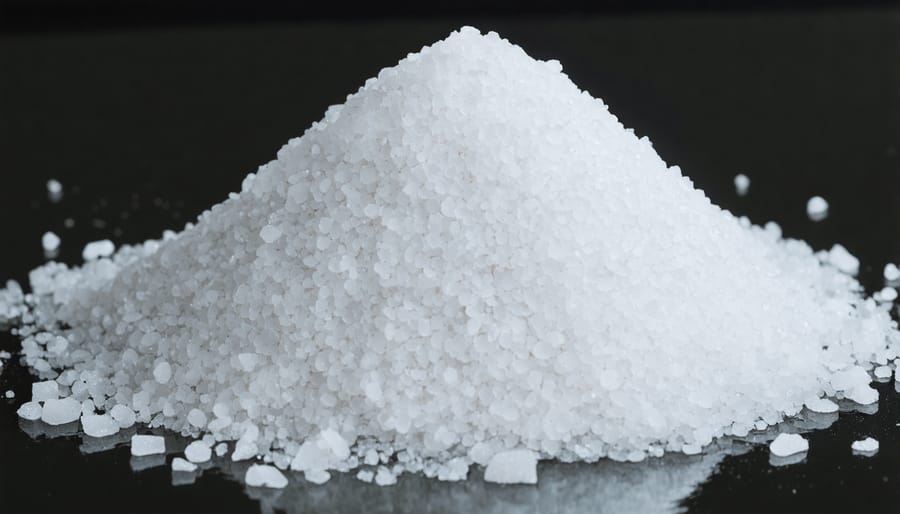
Common Reasons Salt Stops Dissolving
Salt Bridging: The Hard Crust Problem
Salt bridging occurs when a hard, crusty shell forms in your brine tank, creating a hollow space between the salt and the water below. This solid crust essentially acts as a false floor, preventing fresh salt from dissolving into the water where it’s needed. Think of it like a frozen layer on a pond—everything looks normal on top, but underneath, there’s a gap that disrupts the natural process.
You can identify salt bridging by gently pushing a broom handle down through the salt. If you feel resistance before reaching the tank bottom, or if you hear a hollow sound when tapping the salt surface, you’ve likely found a bridge. Visually, your salt level might appear unchanged for weeks, even though your softener seems low on brine.
This frustrating problem typically develops when humidity, temperature fluctuations, or poor-quality salt cause granules to stick together and harden. The bridge blocks water from reaching the salt supply above it, meaning your softener can’t create the brine solution necessary for regeneration. Without proper brine, hard water minerals pass through untreated, defeating your system’s entire purpose and potentially affecting your household’s water quality and appliance longevity.
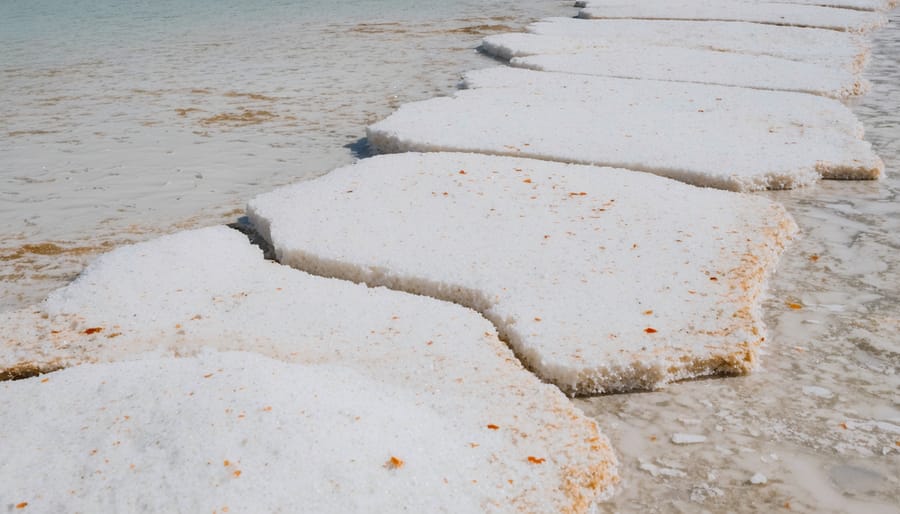
Salt Mushing: The Sludge at the Bottom
Salt mushing occurs when dissolved salt recrystallizes at the bottom of your brine tank, forming a thick, hardened sludge instead of the liquid brine your system needs. This frustrating phenomenon happens when salt dissolves too slowly—often due to high humidity, temperature fluctuations, or poor water circulation in the tank. The result? A crusty barrier that prevents fresh salt from reaching the water below.
Think of it like wet sand at the beach that’s been compacted—it creates a nearly impermeable layer. This sludge blocks your softener from creating the proper brine concentration needed for regeneration, leaving you with hard water despite a tank full of salt.
Mushing is particularly common when using lower-quality salt containing excessive impurities, which don’t fully dissolve and contribute to buildup. The good news? It’s fixable. You’ll need to break up the crust manually and remove the sludge, then clean your brine tank thoroughly. To prevent future mushing, maintain proper humidity levels around your softener, avoid overfilling the tank, and choose high-purity salt products. Regular tank inspections—every few months—help catch early signs before they become a bigger problem.
Poor Quality or Wrong Salt Type
Not all salt is created equal when it comes to water softeners. The type and quality of salt you choose directly impacts how well it dissolves and how efficiently your system operates.
Rock salt, the most affordable option, contains high levels of impurities and insoluble minerals. While budget-friendly, these impurities don’t dissolve in water and instead settle at the bottom of your brine tank as muddy sludge. Over time, this buildup creates a barrier that prevents proper salt dissolution and forces your softener to work harder—ultimately costing you more in maintenance and repairs.
Table salt or iodized salt might seem like a convenient alternative, but it’s not designed for water softening systems. The anti-caking agents and iodine additives can leave residue and may even damage your softener’s components. These household salts also lack the coarse grain structure needed for gradual, controlled dissolution.
Low-purity solar salt falls somewhere in the middle. While cleaner than rock salt, lower grades still contain enough impurities to cause problems. You’ll notice white or gray residue accumulating in your tank—a telltale sign that your salt isn’t dissolving completely.
For optimal performance and minimal environmental impact, choose high-purity salt pellets or crystals specifically manufactured for water softeners. These premium options contain 99.5% pure salt or higher, dissolving cleanly without leaving behind harmful residue. Though slightly more expensive upfront, they protect your system from buildup, reduce cleaning frequency, and extend your softener’s lifespan—making them the more sustainable and cost-effective choice long-term.
Choosing the Right Salt to Prevent Dissolution Problems
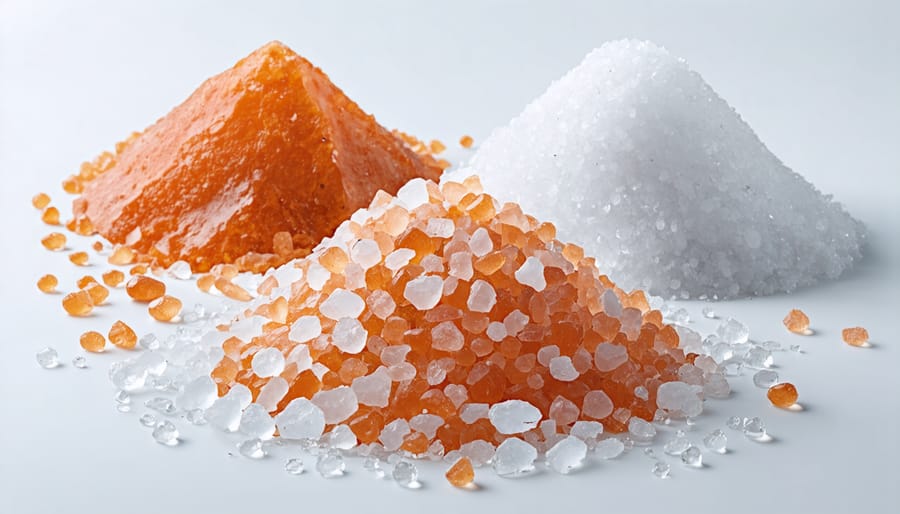
Solar Salt vs. Evaporated Salt: What Dissolves Better
When choosing salt for your water softener, understanding the difference between solar salt and evaporated salt can help prevent dissolution problems and keep your system running smoothly.
**Solar salt** is produced by evaporating seawater in outdoor ponds using the sun’s natural energy. While this eco-friendly production method appeals to environmentally-conscious homeowners, solar salt typically contains 85-99% purity. The remaining minerals and impurities can sometimes slow dissolution rates and contribute to tank buildup over time.
**Evaporated salt** undergoes mechanical evaporation and purification processes, resulting in 99.99% purity. This higher purity level means it dissolves more consistently and leaves minimal residue in your brine tank. Though it requires more energy to produce, many users find it reduces maintenance needs and prevents bridging issues.
For optimal performance, evaporated salt generally dissolves better due to its superior purity. However, high-quality solar salt can work effectively in most systems when proper maintenance practices are followed. Your choice depends on balancing environmental priorities with system requirements. Consider exploring options for the best water softener salt that matches both your softener’s needs and your sustainability values, keeping in mind that proper storage and regular tank maintenance matter as much as salt type.
Crystal vs. Pellet Form: Which Works Best
The type of salt you choose significantly impacts how well it dissolves in your water softener system. Salt comes in two primary forms: crystals and pellets, each with distinct characteristics that affect performance.
**Crystal salt** is created through solar evaporation, resulting in larger, coarser granules. While budget-friendly, crystals dissolve more slowly and can leave behind more residue. They work best in households with lower water usage, but may contribute to bridging issues in humid environments.
**Pellet salt** (also called compressed salt) is manufactured by compacting smaller salt particles into uniform shapes. These pellets dissolve more efficiently and leave minimal residue, making them the preferred choice for most modern water softeners. Their consistent size promotes even dissolution and reduces the likelihood of mushing or clumping.
For eco-conscious homeowners, pellets offer an environmental advantage by reducing waste and improving system efficiency. They help your softener operate at peak performance, which means less water and salt consumption over time. If you’re experiencing dissolution problems, switching from crystals to high-purity pellets often resolves the issue while supporting more sustainable household water management.
Why Purity Percentage Matters
Not all water softener salt is created equal, and the purity percentage printed on the bag plays a crucial role in how well it dissolves. Standard salt typically contains about 95% sodium chloride, while premium options boast 99.6% purity. That 4.6% difference might seem small, but it represents impurities—minerals, sediments, and fillers—that don’t dissolve in water.
When you use lower-purity salt, these impurities accumulate at the bottom of your brine tank as a muddy residue called “mushing.” This buildup blocks water flow and prevents proper salt dissolution, forcing your softener to work harder and less efficiently. Higher-purity high-quality salt types dissolve more completely, leaving minimal residue behind.
From an environmental perspective, cleaner-dissolving salt means fewer tank cleanouts and less wastewater from maintenance. You’ll also use less salt overall since more of it actually serves its purpose rather than turning into sludge. While premium salt costs slightly more upfront, the reduced maintenance, improved system longevity, and lower environmental impact make it a worthwhile investment for both your home and the planet.
How to Fix Undissolved Salt Right Now
Breaking Up Salt Bridges Safely
A salt bridge forms when hardened salt creates a hollow dome above the water level, preventing fresh salt from dissolving. To identify one, gently push a broom handle straight down into your tank—if it hits resistance before reaching the bottom or feels hollow underneath, you’ve found a bridge.
To safely break it apart, use a long wooden broom handle or plastic rod (never metal, which could scratch the tank). Carefully tap around the hardened mass to crack it into smaller pieces. Work slowly and avoid excessive force that might damage the tank walls or internal components. Once broken, remove larger chunks by hand and let smaller pieces dissolve naturally.
After clearing the bridge, run a manual regeneration cycle to restore proper system function. This eco-friendly DIY fix saves water and prevents unnecessary service calls, keeping your softener running efficiently while reducing environmental impact from wasted resources.
Removing Salt Mush and Cleaning Your Tank
When salt mush becomes a problem, a thorough cleaning is your best solution. Start by turning off your water softener and disconnecting the power supply for safety. Use a wet-dry vacuum or bucket to remove as much water as possible from the brine tank—this makes the job much easier and less messy.
Next, scoop out any undissolved salt and stubborn sludge buildup at the bottom. You’ll likely find a thick, pasty layer that’s preventing proper salt dissolution. Once emptied, scrub the tank walls and bottom with warm water and a stiff brush—avoid harsh chemicals that could damage the system or contaminate your water supply. A simple mixture of dish soap and water works wonderfully for this eco-friendly cleaning approach.
Rinse the tank thoroughly multiple times to remove all residue. Check the brine well (the smaller tube inside the tank) and clean any salt bridges or blockages there too. Before refilling with fresh, high-quality salt, inspect the float assembly and ensure it moves freely. This preventive step helps maintain optimal water softening performance while reducing future maintenance needs and extending your system’s lifespan.
Adjusting Water Levels
Proper water levels are essential for salt to dissolve effectively. Check your brine tank—the water should reach 6-12 inches from the bottom, just enough to cover the salt grid or platform. If water levels are too low, salt can’t dissolve; too high creates a supersaturated solution that wastes salt and reduces efficiency. Look for the salt platform (usually a few inches above the tank floor) and ensure water sits just above it. If levels seem off, your float valve may need adjustment or cleaning. This simple check can restore your system’s performance while conserving resources.
Preventing Future Salt Dissolution Issues
Storage Tips for Your Salt Supply
Proper storage prevents salt from absorbing moisture and forming clumps before it even reaches your softener. Store salt bags in a cool, dry location away from humid areas like basements near water heaters or washing machines. Keep bags elevated off concrete floors using pallets or shelves, as concrete naturally draws moisture that can seep through packaging.
Once opened, seal bags tightly with clips or transfer salt to airtight containers with tight-fitting lids. This simple step significantly reduces humidity exposure. Avoid storing salt outdoors or in unheated garages where temperature fluctuations create condensation.
Buy only what you’ll use within 2-3 months to minimize storage time and potential moisture absorption. This approach not only keeps your salt flowing freely but also reduces packaging waste—a small win for eco-conscious homeowners. Fresh, properly stored salt dissolves efficiently, keeping your water softener running smoothly and your household water quality consistently high.
Regular Maintenance Schedule
Preventing salt buildup starts with consistent monitoring. Check your brine tank monthly to catch issues before they escalate. During your inspection, look for salt bridges (hardened crusts above water), mushy salt at the bottom, or unusual discoloration that might indicate contamination.
Every three months, break up any clumping you notice and ensure salt levels stay at least one-quarter full but never exceed two-thirds capacity. Overfilling restricts proper water circulation and creates the perfect environment for bridging. A quality water softener system will last longer with this simple routine.
Annually, schedule a deeper clean. Empty remaining salt, scrub away residue buildup with warm water, and inspect mechanical components for wear. This thorough maintenance prevents mineral deposits from accumulating and keeps your system running efficiently.
Set calendar reminders for these tasks—they take just minutes but save you from costly repairs and water quality issues. Think of it as preventive care for your home’s water health. Regular attention means your softener works optimally while using less salt overall, reducing both environmental impact and household expenses. Consistency is key to avoiding dissolution problems entirely.
Environmental Impact of Your Salt Choice
Your salt choice affects more than just your water softener’s performance—it impacts the environment too. When your softener regenerates, it discharges brine into wastewater systems, eventually reaching treatment plants or natural waterways. High-purity salts like solar or evaporated varieties dissolve completely, reducing sediment buildup and the need for frequent system flushes, which means less wastewater overall.
Lower-quality rock salt often contains insoluble minerals and contaminants that don’t dissolve, creating sludge that requires additional water to flush out. This increases your household’s wastewater discharge and can burden municipal treatment facilities. By choosing cleaner salts, you’re minimizing this environmental footprint while keeping your system running efficiently.
Consider the sourcing too. Solar salt harvested through natural evaporation requires less energy to produce than mined rock salt, making it a more sustainable choice. Some manufacturers now offer salt from responsibly managed sources with third-party certifications.
For homeowners seeking the most eco-friendly approach, salt-free water softener systems eliminate discharge concerns entirely by using alternative technologies like template-assisted crystallization instead of ion exchange. While traditional softeners remain popular for their effectiveness, switching to high-purity salts represents a meaningful middle ground—protecting both your investment and the environment by reducing dissolution problems and minimizing ecological impact with every regeneration cycle.
Choosing the right salt for your water softener isn’t just about keeping your system running—it’s about protecting your investment and ensuring clean, soft water flows through your home every day. If you’re currently dealing with undissolved salt, take a moment to examine what type you’re using and how you’re storing it. Simple changes like switching from rock salt to higher-purity options or keeping your salt dry can prevent frustrating clogs and expensive repairs down the road.
Beyond convenience, proper salt dissolution directly impacts your household’s water quality and efficiency. When salt dissolves correctly, your softener uses less water during regeneration cycles, reduces waste, and operates at peak performance—all contributing to more sustainable home water management. Regular maintenance checks, combined with quality salt selection, mean fewer service calls, lower energy consumption, and a system that reliably delivers soft water for years to come. By understanding these connections, you’re not just troubleshooting a problem; you’re embracing smarter, more eco-conscious water care practices that benefit both your home and the environment.
